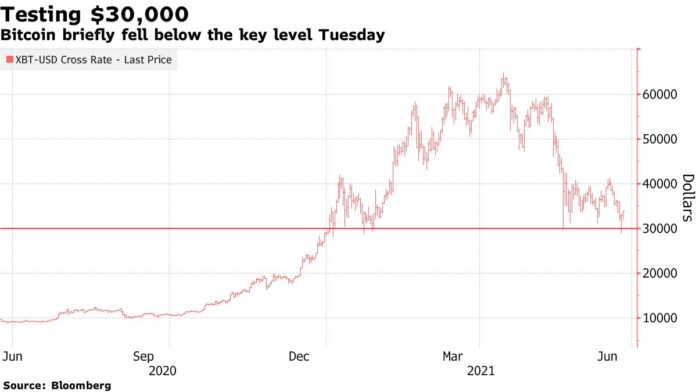
Bitcoin extended gains in Asia trading Wednesday, bouncing back after earlier whipsawing investors with a dip below the $30,000 level.
The largest cryptocurrency rose as much as 4.5% and was trading at $33,837 as of 9:38 a.m. in Hong Kong. The coin plunged 12% at one point during U.S. trading hours Tuesday to hit $28,824, which briefly took it into negative territory for the year. Prior to that, it hadn’t fallen below $30,000 since January.
Bitcoin has lost more than 50% from its mid-April high of almost $65,000. The coin started 2021 trading around $29,000 following a fourfold increase in 2020.
Such trading signals “that Bitcoin traders could find themselves in choppy waters for weeks to come,” said Sean Rooney, head of research at crypto asset manager Valkyrie Investments.
Chart-watchers said Bitcoin, which failed to stay above $40,000 last week, could have a tough time finding support in the $20,000 range following its drop below $30,000. Still, Bitcoin had prior to Tuesday breached $30,000 during at least five separate instances this year but recuperated to trade above that level each time.
“Any meaningful break below $30,000 is going to make a lot of momentum players to throw in the towel,” said Matt Maley, chief market strategist for Miller Tabak + Co. “Therefore, even if Bitcoin is going to change the world over the long-term, it does not mean it cannot fall back into the teens over the short-term.”
It’s a remarkable comedown for the digital asset which just weeks ago was trekking higher amid a warmer embrace from Wall Street as well as retail investors. But negative attention about its energy use, brought on largely by Tesla Inc.’s Elon Musk, as well as a clampdown from China have pushed it lower in recent weeks.
China’s latest broadside came Monday, when the nation’s central bank said it had summoned officials from the biggest lenders as well as AliPay to reiterate a ban on cryptocurrency services. Chinese officials are already trying to root out crypto mining operations.
“Bitcoin’s continued sell-off has contributed to a negative outlook by traders driven by bearish news out of China,” said Nick Mancini, research analyst at crypto sentiment analytics provider Trade The Chain. “The mood among traders is now continuing to sour.”
Exuberant rallies and quick drawdowns are not uncommon for Bitcoin and other cryptocurrencies. Bitcoin underwent a renaissance in 2017, rising more than 1,000% that year, only to lose roughly 75% in the following year. And last year, it advanced 300%.
“The most speculative part of the market is cryptocurrency,” said Eric Diton, president and managing director of The Wealth Alliance. “At the end of the day, what determines the value of Bitcoin is acceptance and more demand and supply. When you have a country like China come out against Bitcoin, that really hurts it’s global acceptance and that’s why you’re seeing the value deteriorate as much as it has.”









